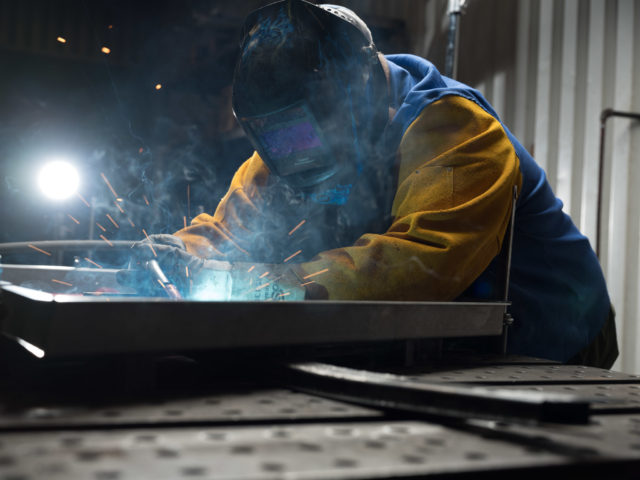Welding stainless steel has its challenges and differences. Though not as difficult to weld as some metals, stainless steel has specific properties that vary from other more common steels that should be addressed before welding.
Stainless steel is a nonferrous metal alloy of iron, carbon, and a minimum of 10.5% chromium. It’s known for its strength and corrosion resistance. The many different grades of stainless steel are determined by the degree and combination of other elements mixed with the iron, carbon, and chromium such as nickel, niobium, molybdenum, and titanium. The addition of chromium to the alloy–which is resistant to rust and tarnishing—also gives the metal its familiar shine.
A Guide to Welding Stainless Steel
Stainless steel has a wide variety of industrial applications. Primary uses are for architectural paneling, food processing and other kitchen equipment, aerospace, automotive, and marine equipment. Because of its wide use, it’s a popular metal in many welding applications for industrial equipment.
To achieve an aesthetic result when welding stainless steel, regardless of your method, heating and cooling of the metal must be controlled. The metal is known to retain heat, which can lead to problems like warping, rust, or embrittlement. Too much heat, as few as five amps, can mean the difference between a burned seam and perfection. Secondly, make sure the filler metals match the material being welded. Finally, ensure a clean working space and keep debris off the welding table, as stainless steel can scratch very easily.
Most importantly, welding stainless steel requires ventilation. Because of the chromium, the fumes can be toxic. Exhaust fans, special smoke suction tips attached to the welding torch, and a breathing apparatus are all highly advised to keep the fumes and harmful smoke away from the welder.
The three most common methods for welding stainless steel are TIG Welding, MIG Welding, and Resistance Welding. Each has their own benefits and unique characteristics.
TIG Welding
TIG stands for Tungsten Inert Gas, which is short for Gas Tungsten Arc Welding (GTAW). It’s named for the tungsten electrode, and the inert gas sheathing surrounding it. The non-consumable tungsten electrode delivers the current to a welding arc. Argon gas is used because it protects and cools the tungsten, creates much less smoke than other gases, and prevents oxidization.
TIG welding is ideal for critical joints and is widely used in the industry for fine, precise welds, and it is the most common method for welding thin stainless steel sections on thinner metals. Benefits for using TIG Welding on stainless steel include, low electrode wear, pore-free, sound welds, concentrated heat source, which in turn leads to a narrow fusion zone, precise control, a very stable arc, welding with or without filler, and oxidation residue is eliminated, resulting in a simplified final cleaning process.
MIG Welding
Metal Inert Gas, MIG welding, also known as, Gas Metal Arc Welding (GMAW), is the welding process that uses electricity to melt and join pieces of metal together. In the world of welding, it’s often referred to as the “hot glue gun” and was developed in the 1940s for welding non-ferrous metals. MIG welding requires a wire to be connected to a source of direct current that acts as an electrode to join two pieces of metal while it continuously passes through a welding gun. The shielding gas mix for MIG welding stainless steel is 90% helium, 7.5% argon, 2.5% carbon dioxide.
The primary advantage of MIG welding is that it allows the metal to be welded much more quickly than traditional “stick welding” techniques. MIG welding method produces long, continuous welds much faster and can be used on thicker stainless steel in applications where long weld lines are needed. Because the shielding gas protects the welding arc, this type of welding produces a clean weld with very little splatter.
Resistance Welding
Resistance welding is the welding process for spot and seam welding. When electrical current sent through an electrode comes into contact with the metal, both resistance heat and a nugget are produced. The end result is a metal joint. Though it requires substantial amounts of current from its power source, it uses low voltage to operate.
In manufacturing, compared to other methods of welding, resistance welding can be much more efficient as it only requires pressing a button to perform the process. Particularly with regard to stainless steel, heating time and heat concentration are less, and thus affects less of an area being worked on. For manufacturers, the process can be mechanized and automated and does not require long hours of pre-service training for welders. The result is not only aesthetically pleasing but high productivity and low cost, creating fewer fumes and a healthier working environment, which overall is more cost-effective for manufacturers.
Unsure of which method would suit your specific needs? Feel free to contact us today, our knowledgeable and friendly staff are here to help!



